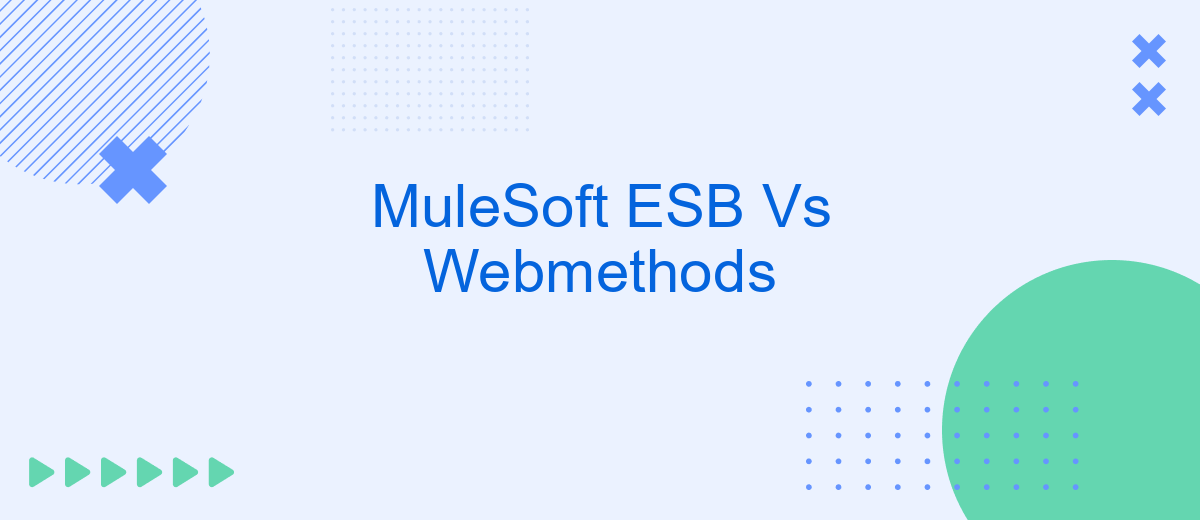When considering integration platforms for modern enterprises, MuleSoft ESB and WebMethods often emerge as top contenders. Both offer robust solutions for connecting diverse systems and streamlining business processes. This article delves into a detailed comparison of MuleSoft ESB and WebMethods, examining their features, strengths, and potential limitations to help you make an informed decision for your organization's integration needs.
Introduction
In today's fast-paced digital landscape, businesses are increasingly relying on integration platforms to streamline their operations and connect disparate systems. MuleSoft ESB and Webmethods are two prominent players in the field of enterprise service buses (ESBs). Both platforms offer robust solutions for integrating applications, services, and data across various environments, but they come with their own unique features and capabilities.
- MuleSoft ESB: Known for its flexibility and ease of use, MuleSoft ESB enables developers to create integrations quickly using its Anypoint Platform.
- Webmethods: A comprehensive suite from Software AG, Webmethods provides extensive tools for application integration, business process management, and API management.
- SaveMyLeads: This service simplifies the integration process by automating lead data transfers between various platforms, ensuring seamless connectivity.
Choosing the right ESB solution depends on various factors including specific business requirements, existing IT infrastructure, and budget constraints. In this article, we will delve deeper into the features, advantages, and limitations of MuleSoft ESB and Webmethods to help you make an informed decision. Additionally, we'll explore how services like SaveMyLeads can complement these platforms by automating and streamlining integration tasks.
Comparison of Features

MuleSoft ESB and Webmethods are two prominent integration platforms, each with its own unique set of features. MuleSoft ESB offers a highly flexible and scalable architecture, making it suitable for a wide range of integration scenarios. It supports API-led connectivity, which allows developers to create APIs that can be reused across different projects. MuleSoft also provides a robust set of tools for monitoring and managing integrations, ensuring that businesses can maintain seamless operations. On the other hand, Webmethods excels in providing a comprehensive suite of tools for application integration, business process management, and B2B integration. Its strong emphasis on process automation and data management helps organizations streamline their workflows and improve efficiency.
Both platforms offer extensive support for various protocols and standards, but MuleSoft's Anypoint Platform stands out with its user-friendly interface and pre-built connectors, which simplify the integration process. Webmethods, however, offers deep integration capabilities with enterprise systems and excels in handling complex integration requirements. Additionally, services like SaveMyLeads can enhance the integration experience by providing automated data transfer between different applications, reducing manual effort and minimizing errors. Ultimately, the choice between MuleSoft ESB and Webmethods depends on the specific needs and priorities of the organization.
Integration Capabilities

MuleSoft ESB and Webmethods are two leading integration platforms, each offering robust capabilities for connecting disparate systems and applications. MuleSoft ESB, known for its flexibility and scalability, leverages APIs to facilitate seamless integration. On the other hand, Webmethods provides a comprehensive suite of tools for enterprise integration, focusing on reliability and extensive support for various protocols.
- MuleSoft ESB utilizes a lightweight, Java-based architecture that supports RESTful APIs, SOAP, and various messaging protocols.
- Webmethods offers extensive support for B2B integrations, EDI, and a wide range of connectors for different enterprise systems.
- Both platforms provide robust data transformation and mapping capabilities, ensuring smooth data flow between systems.
For businesses looking to streamline their integration processes, tools like SaveMyLeads can be invaluable. SaveMyLeads automates lead data transfer between various platforms, reducing manual effort and ensuring timely data updates. By leveraging such services, companies can enhance the efficiency and reliability of their integration strategies, regardless of the platform they choose.
Enterprise Support

When it comes to enterprise support, both MuleSoft ESB and WebMethods offer robust options designed to meet the complex needs of large organizations. These platforms provide extensive documentation, dedicated support teams, and comprehensive training programs to ensure smooth implementation and operation.
MuleSoft ESB excels in providing a wide range of support services, including 24/7 customer support, a detailed knowledge base, and access to community forums. Additionally, MuleSoft offers professional services to help businesses with integration strategies and custom solutions.
- 24/7 customer support
- Extensive documentation and knowledge base
- Community forums for peer assistance
- Professional services for custom solutions
Similarly, WebMethods provides a high level of enterprise support, featuring dedicated account managers, technical support, and a rich set of online resources. For businesses looking to streamline their integration processes, services like SaveMyLeads can be invaluable, offering automated lead integrations that save time and reduce manual errors.
Cost and Licensing
When comparing MuleSoft ESB and Webmethods in terms of cost and licensing, it's essential to consider the different pricing models and the value they provide. MuleSoft operates on a subscription-based model, which can be more predictable for budgeting but might seem steep for smaller businesses. The cost generally scales with the number of integrations and the complexity of your needs. Additionally, MuleSoft offers a variety of licensing options, including cloud-based and on-premises solutions, providing flexibility depending on your deployment preferences.
Webmethods, on the other hand, typically follows a more traditional licensing approach, which might involve higher upfront costs but could potentially be more economical in the long run for large enterprises. Like MuleSoft, Webmethods offers both cloud and on-premises solutions. For businesses looking for more straightforward, cost-effective integration solutions, services like SaveMyLeads can be an excellent alternative. SaveMyLeads provides automated integration setups, reducing the need for extensive manual configurations and thereby cutting down on both time and costs associated with complex integration projects.
FAQ
What are the primary differences between MuleSoft ESB and Webmethods?
Which platform is better for cloud integration?
How do MuleSoft ESB and Webmethods handle API management?
What are the cost implications of using MuleSoft ESB vs Webmethods?
Are there services available to assist with the automation and integration setup for these platforms?
Personalized responses to new clients from Facebook/Instagram. Receiving data on new orders in real time. Prompt delivery of information to all employees who are involved in lead processing. All this can be done automatically. With the SaveMyLeads service, you will be able to easily create integrations for Facebook Lead Ads and implement automation. Set up the integration once and let it do the chores every day.
